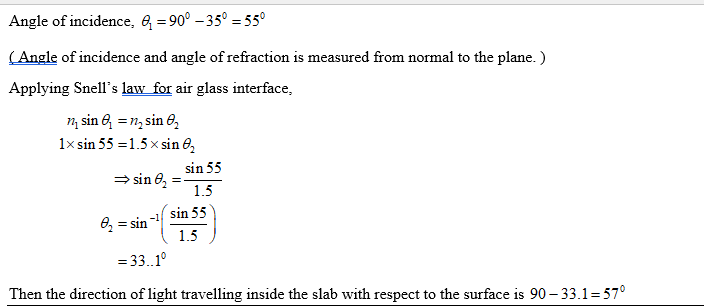Suppose you are performing experiment in the lab by passing light ray to a slab of geometry of thickness 2-cm which is transparent. The angle made by the light ray through the horizontal surface of the slab is 35-degree. What is the light ray direction of travel in the slab and exiting from the slab? Assume refractive index of glass is 1.5 and air is 1.0.
Ray Optics
Optics is the study of light in the field of physics. It refers to the study and properties of light. Optical phenomena can be classified into three categories: ray optics, wave optics, and quantum optics. Geometrical optics, also known as ray optics, is an optics model that explains light propagation using rays. In an optical device, a ray is a direction along which light energy is transmitted from one point to another. Geometric optics assumes that waves (rays) move in straight lines before they reach a surface. When a ray collides with a surface, it can bounce back (reflect) or bend (refract), but it continues in a straight line. The laws of reflection and refraction are the fundamental laws of geometrical optics. Light is an electromagnetic wave with a wavelength that falls within the visible spectrum.
Converging Lens
Converging lens, also known as a convex lens, is thinner at the upper and lower edges and thicker at the center. The edges are curved outwards. This lens can converge a beam of parallel rays of light that is coming from outside and focus it on a point on the other side of the lens.
Plano-Convex Lens
To understand the topic well we will first break down the name of the topic, ‘Plano Convex lens’ into three separate words and look at them individually.
Lateral Magnification
In very simple terms, the same object can be viewed in enlarged versions of itself, which we call magnification. To rephrase, magnification is the ability to enlarge the image of an object without physically altering its dimensions and structure. This process is mainly done to get an even more detailed view of the object by scaling up the image. A lot of daily life examples for this can be the use of magnifying glasses, projectors, and microscopes in laboratories. This plays a vital role in the fields of research and development and to some extent even our daily lives; our daily activity of magnifying images and texts on our mobile screen for a better look is nothing other than magnification.
![**Experiment on Refraction of Light Through a Transparent Slab**
In this experiment, you will pass a light ray through a transparent slab of glass with a thickness of 2 cm. The light ray makes an angle of 35 degrees with the normal as it enters through the horizontal surface of the slab. The objective of the experiment is to determine the direction in which the light travels within the slab and as it exits the slab.
For this experiment, assume the refractive index of the glass is 1.5 and the refractive index of air is 1.0.
**Procedure:**
1. Align the light source so that the light ray enters the slab at a 35-degree angle to the normal.
2. Observe the change in direction of the light ray as it travels through the slab and exits.
3. Use Snell's Law to calculate the angles of refraction within the slab and upon exiting.
**Theoretical Background:**
Snell's Law is given by:
\[ n_1 \sin(\theta_1) = n_2 \sin(\theta_2) \]
Where:
- \( n_1 \) and \( n_2 \) are the refractive indices of the first and second medium respectively.
- \( \theta_1 \) is the angle of incidence.
- \( \theta_2 \) is the angle of refraction.
**Expected Outcomes and Analysis:**
- Calculate the angle of refraction as the light enters the slab using Snell’s Law.
- Determine how the path of light is altered within the slab.
- Analyze and compare the angle of exit with the initial angle of incidence to understand the effects of refraction.
This experiment helps demonstrate the principles of refraction and the behavior of light as it moves between different media.](/v2/_next/image?url=https%3A%2F%2Fcontent.bartleby.com%2Fqna-images%2Fquestion%2F70eaa308-4455-4063-a32e-acd6ba723e7f%2F1f592655-e2dc-4556-9097-92a48755514f%2Fgnpbtyd_processed.jpeg&w=3840&q=75)

Step by step
Solved in 2 steps with 2 images









